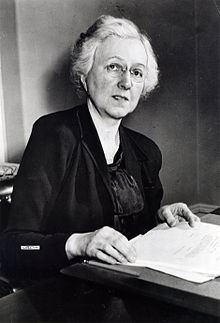Name Chase Woodhouse Full Name Chase Going | Political party Democratic Books Italy and the Jugoslavs Spouse(s) Edward Woodhouse | |
 | ||
Preceded by Horace Seely-Brown, Jr. Succeeded by Horace Seely-Brown, Jr. Born March 3, 1890Victoria, British Columbia, Canada ( 1890-03-03 ) Education | ||
Chase Going Woodhouse (March 3, 1890 – December 12, 1984) was an educator and Congresswoman from the Second Congressional District in Connecticut. She was the second woman elected to Congress from Connecticut, and the first elected as a Democrat.
Contents
Biography
Woodhouse was born in Victoria, British Columbia, Canada and graduated from Science Hill School, Shelbyville, Kentucky, 1908. She graduated from McGill University, Montreal, Quebec, Canada, in 1912, earning a Bachelor of Arts degree and a Masters of Arts degree with Honors in Economics. She then studied at the University of Berlin and the University of Chicago. She began her career as a college professor and spent the latter part of her career as a well-known political figure from Connecticut. While serving as a fellow in political economics at the University of Chicago, Chase Going met and married a professor of government, Edward Woodhouse. They had two children, Noel and Margaret.[1]
Political career
In her early career, she was a senior economist at the Bureau of Home Economics, United States Department of Agriculture, from 1926 to 1928. Shortly after moving to New London, Connecticut in 1934, Woodhouse registered to vote as a Democrat. In 1940, she was the first Democratic woman to be elected as Secretary of State for Connecticut, serving one term. She also served as chair of the New London, Democratic Town Committee in 1942 and 1943. During World War II Woodhouse was a consultant for the National Roster of Scientific and Specialized Personnel, War Manpower Commission, from 1942 to 1944. She was president of the Connecticut Federation of Democratic Women’s Clubs, from 1943 to 1948, which is the oldest federation of Democratic Women's Clubs in the nation.
While teaching economics at Connecticut College, Woodhouse began her run for the United States Congress. She was elected as a Democrat to the Seventy-ninth Congress and served from January 3, 1945 to January 3, 1947. She defeated Republican, John D. McWilliams from Norwich, with a plurality of 3,046 compared to McWilliams plurality of 2,492. In this election many cities in Eastern Connecticut, like Norwich and New London voted Democrat, while smaller towns voted Republican. While in office, she was a political activist for women's advancement in careers beyond education, focusing on combining motherhood and feminism. Woodhouse introduced the bill, "H.R. 1584", to the subcommittee of the House Committee on Education and Labor, which identified unequal labor practices and wages between men and women. She ran for reelection to the Eightieth Congress in 1946 but was defeated. While out of office, she was Executive Director of the women’s division of the Democratic National Committee (DNC), based in Washington, D.C., in 1947 and 1948. Democrats, like President Harry Truman believed Woodhouse was a valuable link to women voters and encouraged this appointment. Woodhouse then served again in the Eighty-first Congress from January 3, 1949 to January 3, 1951, after defeating Horace-Seely Brown in 1948. She was also a visiting expert on the staff of General Lucius D. Clay, Allied Military Governor of Germany, in 1948.[2] She was again defeated for reelection to the Eighty-second Congress in 1950. Woodhouse began serving as the director of the Auerbach Service Bureau for Connecticut Organizations in Hartford in 1954. She was also a member of the Permanent Commission on the Status of Women and served on the Connecticut Humanities Council.
Woodhouse was appointed to the Banking and Currency Committee while serving in the United States Congress. She was special assistant to the Director of Price Stabilization, from 1951 to 1953, and a delegate to the Connecticut state Constitutional Convention, 1965. In 1967, she served as the chairman of the Governor's Committee on the Status of Women. She then served as a member of the Advisory Committee to the State Department of Community Affairs from 1967 until 1972. Woodhouse was also a member of Comprehensive Health Planning Council, the Steering Committee of the Connecticut Mental Health Planning Project, the Advisory Council to the Board of Mental Health, the Connecticut Humanities Council, and the State Commission of Housing and New Communities. Woodhouse also regularly contributed to Planned Parenthood and was a proponent of environmental legislation. She earned the Ella T. Grasso Award for Outstanding Service at the end of her career.
Career in Education
Woodhouse served on the faculty of Smith College, Northampton, Massachusetts, from 1918 to 1925. She was on the faculty of Connecticut College, New London, Connecticut, from 1934 to 1946. She was managing director of the Institute of Women’s Professional Relations at Connecticut College from 1929 until 1946, which she helped found before moving to Connecticut. She also served as the personnel director of the Woman’s College, University of North Carolina at Greensboro, from 1929 through 1934.
Writings
Woodhouse co-wrote three books and numerous articles. Most of her work centered around women's education and their professional lives. The books she cowrote are Occupations for College Women in 1929, After College- What? in 1933, and Dentistry as an Occupation in 1934. Some of the articles she wrote were included in the American Journal of Sociology. A few of her most famous articles are "The Status of Women", published in the American Journal of Sociology in 1931 and "A Study of 250 Successful Families", published in Social Forces in 1930.
Death
Woodhouse died on December 12, 1984, at age 94 years, 284 days, in New Canaan, Connecticut. She was cremated, and the location of her ashes is unknown.
